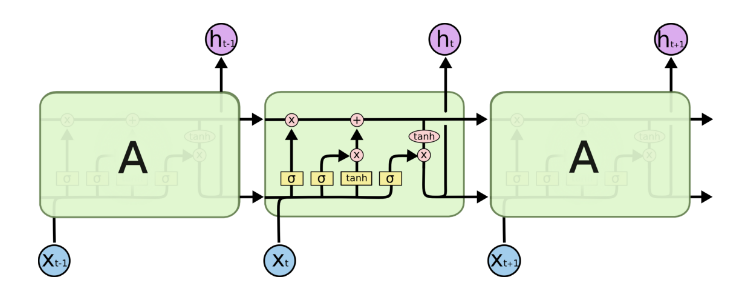TensorFlow技术解析与实战学习笔记(15)-----MNIST识别(LSTM)
一、任务:采用基本的LSTM识别MNIST图片,将其分类成10个数字。
为了使用RNN来分类图片,将每张图片的行看成一个像素序列,因为MNIST图片的大小是28*28像素,所以我们把每一个图像样本看成一行行的序列。因此,共有(28个元素的序列)×(28行),然后每一步输入的序列长度是28,输入的步数是28步。
二、LSTM模型:

输入:x(t-1)的大小为一个28维的向量。……x(t-1),x(t)、x(t+1)……有28个。【将一张图片拆成28*28】
隐藏层大小:128
输出:10
U:28*128
V:128*10
三、LSTM代码:
加载数据:
import tensorflow as tf
from tensorflow.examples.tutorials.mnist import input_data mnist = input_data.read_data_sets('MNIST_data',one_hot = True)
构建模型:
#定义RNN模型:
def RNN(X,w,b,input_size,unit,batch_size):
################################
#输入层,先处理x的shape
#将输入的x转换成(128 batch * 28 time_steps,28 input_size)
X = tf.reshape(X,[-1,input_size])
#####################################
#隐藏层 #输入的大小转换:
# x_in的大小:(128 batch * 28 time_steps ,128 unit)
X_in = tf.matmul(X,w['in']) + b['in']
#将x_in转换成:(128 batch , 28 input_size,128 unit),因为要将其转成张量才能输入LSTM的结构中
X_in = tf.reshape(X_in,[-1,input_size,unit]) #隐藏层模型结构: #BasicLSTMCell 是最简单的LSTMCell.
with tf.variable_scope('lstm',reuse=tf.AUTO_REUSE):
lstm = tf.contrib.rnn.BasicLSTMCell(num_units = unit , forget_bias= 1.0 ,state_is_tuple= True) #初始化状态:lstm单元由两个部分组成:(c_state,h_state)状态值和输出值
init_state = lstm.zero_state(batch_size , dtype = tf.float32) #dynamic_rnn接收张量(batch , steps , inputs) 或者(steps,batch,inputs)作为X_in,其需要输入、隐藏层结构【遗忘门】以及细胞状态
outputs , final_state = tf.nn.dynamic_rnn(lstm , X_in,initial_state = init_state , time_major = False) #########################################################
#输出层
results = tf.matmul(final_state[1],w['out']) + b['out']
return results
训练模型:
1、设置参数(超参数、神经网络参数)
2、前向传播(构建RNN模型)【即构建模型的过程】
3、后向传播(求损失函数、设置优化器)
4、设置会话、训练模型。
def train(mnist):
#设置参数
########################
#设置训练的超参数,学习率、训练次数和每轮训练大小
lr = 0.001
training_iters = 100000
batch_size = 128 #设置神经网络的参数
input_size = 28 #一个输入的向量大小
time_steps = 28 #序列长度
unit = 128 #隐藏层的神经元个数
output_size = 10 #输出 #定义输入数据以及权重
x = tf.placeholder(tf.float32,[None,time_steps,input_size])
y = tf.placeholder(tf.float32,[None,output_size]) # with tf.variable_scope("canshu", reuse=True):
#in大小:(28*128),out大小:(128*10)。
w = {
'in':tf.Variable(tf.random_normal([input_size,unit])),
'out':tf.Variable(tf.random_normal([unit,output_size]))
}
b = {
'in':tf.Variable(tf.constant(0.1,shape = [unit])),
'out':tf.Variable(tf.constant(0.1,shape = [output_size]))
} #################################
##构建模型,定义损失函数和优化器,优化器采用AdamOptimizer with tf.variable_scope('train_op',reuse=tf.AUTO_REUSE):
pred = RNN(x,w,b,input_size,unit,batch_size)
loss = tf.reduce_mean(tf.nn.softmax_cross_entropy_with_logits(logits = pred , labels = y))
train_op = tf.train.AdamOptimizer(lr).minimize(loss) ####################################
#计算模型预测结果以及准确率计算方法
correct_pred = tf.equal(tf.argmax(pred,1),tf.argmax(y,1))
acc = tf.reduce_mean(tf.cast(correct_pred,tf.float32)) ######################################
#训练数据及评估模型
with tf.Session() as sess:
sess.run(tf.global_variables_initializer())
step = 0
while step * batch_size < training_iters:
batch_xs , batch_ys = mnist.train.next_batch(batch_size)
batch_xs = batch_xs.reshape([batch_size,time_steps,input_size])
sess.run([train_op],feed_dict = {
x:batch_xs,
y:batch_ys,
})
if step % 20 == 0:
print(sess.run(acc,feed_dict = {
x:batch_xs,
y:batch_ys,
}))
step += 1
原本代码中没有加红的两句,然后报错:
Variable basic/rnn/basic_lstm_cell/weights does not exist, or was not created with tf.get_variable(). Did you mean to set reuse=None in VarScope?
原因:是因为在BasicRNNCell 使用到了get_variable操作,第一次的时候创建新的variable,第二次调用的时候检测到命名冲突,报错。
加上以下代码:
with tf.variable_scope('lstm',reuse=tf.AUTO_REUSE):
with tf.variable_scope('train_op',reuse=tf.AUTO_REUSE):
四、MultiLSTM代码:比普通的LSTM多了两行红色的代码
加载数据:
import tensorflow as tf
import numpy as np
from tensorflow.examples.tutorials.mnist import input_data
mnist = input_data.read_data_sets('MNIST_data',one_hot = True)
构建模型:
def mLSTM(X,w,b,input_size,unit,batch_size,layer_num):
################################
#输入层,先处理x的shape
#将输入的x转换成(128 batch * 28 time_steps,28 input_size)
X = tf.reshape(X,[-1,input_size])
#####################################
#隐藏层 #输入的大小转换:
# x_in的大小:(128 batch * 28 time_steps ,128 unit)
X_in = tf.matmul(X,w['in']) + b['in']
#将x_in转换成:(128 batch , 28 input_size,128 unit),因为要将其转成张量才能输入LSTM的结构中
X_in = tf.reshape(X_in,[-1,input_size,unit])
#隐藏层模型结构: #BasicLSTMCell 是最简单的LSTMCell.
#state_is_tuple 官方建议设置为True。此时,输入和输出的states为c(cell状态)和h(输出)的二元组
#forget_bias遗忘门的初始值设为 1,一开始不能遗忘
#num_units:num_units这个参数的大小就是LSTM输出结果的维度。例如num_units=128, 那么LSTM网络最后输出就是一个128维的向量。
with tf.variable_scope('lstm',reuse=tf.AUTO_REUSE):
lstm = tf.contrib.rnn.BasicLSTMCell(num_units = unit , forget_bias= 1.0 ,state_is_tuple= True)
lstm = tf.nn.rnn_cell.DropoutWrapper(lstm,0.5)
mlstm = tf.nn.rnn_cell.MultiRNNCell([lstm for i in range(layer_num)])
init_state = mlstm.zero_state(batch_size,dtype = tf.float32)
outputs , final_state = tf.nn.dynamic_rnn(mlstm,X_in,initial_state = init_state,time_major=False)
#初始化状态:lstm单元由两个部分组成:(c_state,h_state)状态值和输出值
# init_state = lstm.zero_state(batch_size , dtype = tf.float32) #dynamic_rnn接收张量(batch , steps , inputs) 或者(steps,batch,inputs)作为X_in,其需要输入、隐藏层结构【遗忘门】以及细胞状态
# outputs , final_state = tf.nn.dynamic_rnn(lstm , X_in,initial_state = init_state , time_major = False) #########################################################33333
#输出层
#final_state的【【维度(128,128)的张量】,【维度为(128,128)的张量】】,因为两层的LSTM。
print(final_state)
results = tf.matmul(final_state[1][1],w['out']) + b['out']
return results
训练模型:
def train(mnist):
#构建模型
########################
#设置训练的超参数,学习率、训练次数和每轮训练大小
lr = 0.001
training_iters = 100000
batch_size = 128 #设置神经网络的参数
input_size = 28 #一个输入的向量大小
time_steps = 28 #序列长度
unit = 128 #隐藏层的神经元个数
output_size = 10 #输出
layer_num = 3 #定义输入数据以及权重
x = tf.placeholder(tf.float32,[None,time_steps,input_size])
y = tf.placeholder(tf.float32,[None,output_size]) # with tf.variable_scope("canshu", reuse=True):
#in大小:(28*128),out大小:(128*10)。
w = {
'in':tf.Variable(tf.random_normal([input_size,unit])),
'out':tf.Variable(tf.random_normal([unit,output_size]))
}
b = {
'in':tf.Variable(tf.constant(0.1,shape = [unit])),
'out':tf.Variable(tf.constant(0.1,shape = [output_size]))
} #################################
#定义损失函数和优化器,优化器采用AdamOptimizer
with tf.variable_scope('train_op',reuse=tf.AUTO_REUSE):
pred = mLSTM(x,w,b,input_size,unit,batch_size,layer_num)
loss = tf.reduce_mean(tf.nn.softmax_cross_entropy_with_logits(logits = pred , labels = y))
train_op = tf.train.AdamOptimizer(lr).minimize(loss) ####################################
#计算模型预测结果以及准确率计算方法
correct_pred = tf.equal(tf.argmax(pred,1),tf.argmax(y,1))
acc = tf.reduce_mean(tf.cast(correct_pred,tf.float32)) ######################################
#训练数据及评估模型
with tf.Session() as sess:
sess.run(tf.global_variables_initializer())
step = 0
while step * batch_size < training_iters:
batch_xs , batch_ys = mnist.train.next_batch(batch_size)
batch_xs = batch_xs.reshape([batch_size,time_steps,input_size])
sess.run([train_op],feed_dict = {
x:batch_xs,
y:batch_ys,
})
if step % 20 == 0:
print(sess.run(acc,feed_dict = {
x:batch_xs,
y:batch_ys,
}))
step += 1
五、双向循环神经网络的代码:
加载模型:
import tensorflow as tf
import numpy as np
from tensorflow.examples.tutorials.mnist import input_data
mnist = input_data.read_data_sets('MNIST_data',one_hot = True)
构建模型:
def BiRNN(x,w,b):
x = tf.transpose(x , [1,0,2])
x = tf.reshape(x,[-1,input_size])
x = tf.split(x,time_steps)
with tf.variable_scope('BiRNN',reuse=tf.AUTO_REUSE):
lstm_fw_cell = tf.contrib.rnn.BasicLSTMCell(hidden_size,forget_bias=1.0,state_is_tuple=True)
lstm_bw_cell = tf.contrib.rnn.BasicLSTMCell(hidden_size,forget_bias=1.0,state_is_tuple=True)
#x为一个长度为T的list,list中的每个Tensor元素shape为[batch_size,input_size]
output , _ , _ = tf.contrib.rnn.static_bidirectional_rnn(lstm_fw_cell,lstm_bw_cell,x,dtype = tf.float32)
result = tf.nn.bias_add(tf.matmul(output[-1],w) , b)
return result
设置参数、训练会话
#设置参数
lr = 0.001
batch_size = 128
training_iters = 20000 input_size = 28
time_steps = 28
output_size = 10
hidden_size = 256 #占位符
X = tf.placeholder(tf.float32,[None,time_steps,input_size])
Y = tf.placeholder(tf.float32,[None,output_size]) with tf.variable_scope('out',reuse=tf.AUTO_REUSE):
w = tf.Variable(tf.truncated_normal([2 * hidden_size , output_size],stddev = 0.1))
b = tf.get_variable('biases',[output_size],initializer = tf.constant_initializer(0.1)) #后向传播
with tf.variable_scope('train_op',reuse=tf.AUTO_REUSE):
pred = BiRNN(X,w,b)
cost = tf.reduce_mean(tf.nn.softmax_cross_entropy_with_logits(logits = pred,labels =Y))
train_op = tf.train.AdamOptimizer(lr).minimize(cost) correct_pred = tf.equal(tf.argmax(pred,1),tf.argmax(Y,1))
acc = tf.reduce_mean(tf.cast(correct_pred,tf.float32)) #训练会话
init = tf.global_variables_initializer()
with tf.Session() as sess:
sess.run(init)
step = 1
while step * batch_size < training_iters:
batch_xs , batch_ys = mnist.train.next_batch(batch_size)
batch_xs = batch_xs.reshape([batch_size,time_steps,input_size])
sess.run(train_op,feed_dict = {X:batch_xs,Y:batch_ys})
if step % 20 == 0:
accuracy = sess.run(acc,feed_dict = {X:batch_xs,Y:batch_ys})
print(accuracy)
step += 1
TensorFlow技术解析与实战学习笔记(15)-----MNIST识别(LSTM)的更多相关文章
- TensorFlow技术解析与实战学习笔记(13)------Mnist识别和卷积神经网络AlexNet
一.AlexNet:共8层:5个卷积层(卷积+池化).3个全连接层,输出到softmax层,产生分类. 论文中lrn层推荐的参数:depth_radius = 4,bias = 1.0 , alpha ...
- 学习TF:《TensorFlow技术解析与实战》PDF+代码
TensorFlow 是谷歌公司开发的深度学习框架,也是目前深度学习的主流框架之一.<TensorFlow技术解析与实战>从深度学习的基础讲起,深入TensorFlow框架原理.模型构建. ...
- 《Tensorflow技术解析与实战》第四章
Tensorflow基础知识 Tensorflow设计理念 (1)将图的定义和图的运行完全分开,因此Tensorflow被认为是一个"符合主义"的库 (2)Tensorflow中涉 ...
- 学习笔记TF058:人脸识别
人脸识别,基于人脸部特征信息识别身份的生物识别技术.摄像机.摄像头采集人脸图像或视频流,自动检测.跟踪图像中人脸,做脸部相关技术处理,人脸检测.人脸关键点检测.人脸验证等.<麻省理工科技评论&g ...
- Elasticsearch技术解析与实战 PDF (内含目录)
Elasticsearch技术解析与实战 介绍: Elasticsearch是一个强[0大0]的搜索引擎,提供了近实时的索引.搜索.分 ...
- elasticsearch技术解析与实战ES
elasticsearch技术解析与实战ES 下载地址: https://pan.baidu.com/s/1NpPX05C0xKx_w9gBYaMJ5w 扫码下面二维码关注公众号回复100008 获取 ...
- Ext.Net学习笔记15:Ext.Net GridPanel 汇总(Summary)用法
Ext.Net学习笔记15:Ext.Net GridPanel 汇总(Summary)用法 Summary的用法和Group一样简单,分为两步: 启用Summary功能 在Feature标签内,添加如 ...
- SQL反模式学习笔记15 分组
目标:查询得到每组的max(或者min等其他聚合函数)值,并且得到这个行的其他字段 反模式:引用非分组列 单值规则:跟在Select之后的选择列表中的每一列,对于每个分组来说都必须返回且仅返回一直值. ...
- 深度学习-tensorflow学习笔记(1)-MNIST手写字体识别预备知识
深度学习-tensorflow学习笔记(1)-MNIST手写字体识别预备知识 在tf第一个例子的时候需要很多预备知识. tf基本知识 香农熵 交叉熵代价函数cross-entropy 卷积神经网络 s ...
随机推荐
- PHP array_intersect_assoc()
定义和用法 array_intersect_assoc() 函数返回两个或多个数组的交集数组. 与 array_intersect() 函数 不同的是,本函数除了比较键值,还比较键名.返回的数组中元素 ...
- 折腾开源WRT的AC无线路由之路-3
来看看Netgear自带的用户界面和具体功能,看看它都能干什么. 開始 一开机.用网线连接到你的电脑上,在浏览器地址栏中输入Netgear默认的路由器地址192.168.1.1,第一次使用时它有个向导 ...
- HDU5567/BestCoder Round #63 (div.2) A sequence1 水
sequence1 Given an array a with length n, could you tell me how many pairs (i,j) ( i < j ) for a ...
- hdoj--5619--Jam's store(最小费用最大流)
Jam's store Time Limit: 2000/1000 MS (Java/Others) Memory Limit: 65536/65536 K (Java/Others) Tota ...
- 【CTSC 2007】 数据备份
[题目链接] https://www.lydsy.com/JudgeOnline/problem.php?id=1150 [算法] 首先,有一个很显然的结论 : 如果要使距离和最小,必须选择相邻的办公 ...
- Java中jspf文件的作用
转自:https://blog.csdn.net/xzmeasy/article/details/75103431 为什么要用jspf文件 写jsp页面时,是不是:css和js引用特别多,而且有些页面 ...
- gulp安装成功但是无法使用
gulp安装正常,但是查看gulp -v和使用gulp的时候报错, 原因:缺少环境变量或环境变量错误. 查找环境变量的方法:在dos下输入npm config get prefix就会显示一个地址,这 ...
- PCB 生产周期计算逻辑与代码实现
PCB生产周期计算逻辑: 代码实现: 调用代码: getWeek(DateTime.Now.Date, ); 周期计算逻辑: /// <summary> /// 获取周期 /// < ...
- Balloons(DFS)
http://acm.sdut.edu.cn/sdutoj/problem.php?action=showproblem&problemid=2248 题意:(1)求图中四连块(有公共边的方块 ...
- Win10,JDK8,tomact7.0.85配置
今天在win10上配置了jdk以及tomact先前使用jdk7+tomact7.0.56运行失败. 后经调整后正确配置注意事项如下: 1.下载并按照jdk-8u161-windows-x64,默认安装 ...
